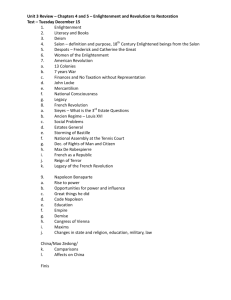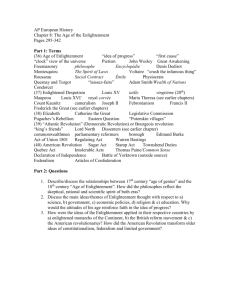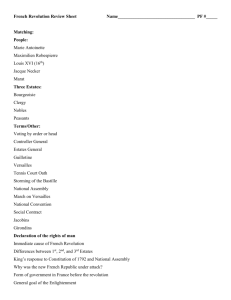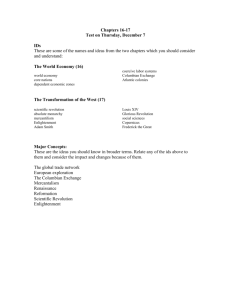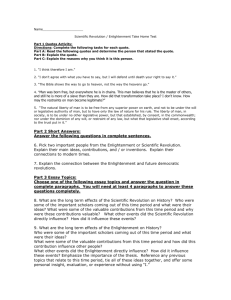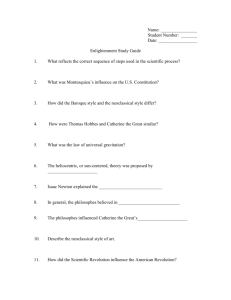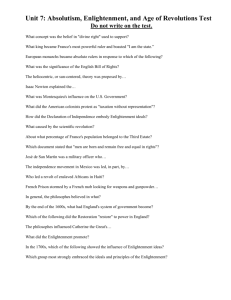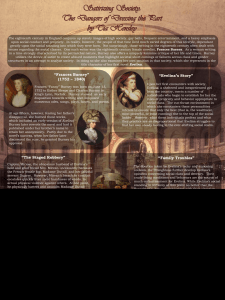© McDougal Littell Inc
advertisement
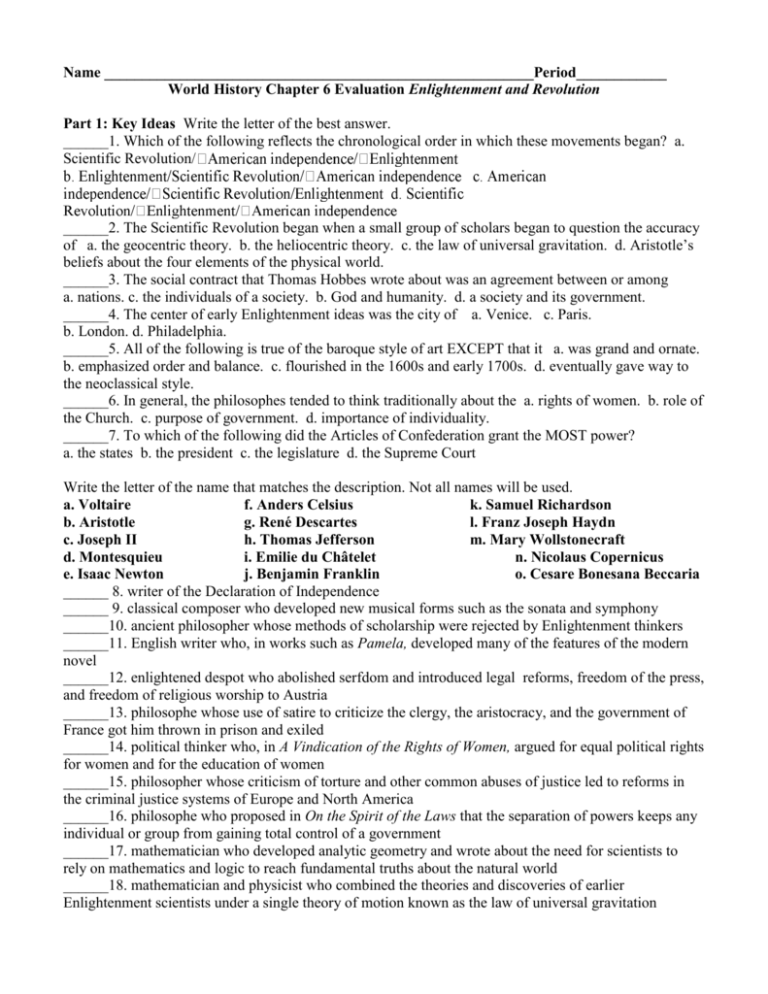
Name _________________________________________________________Period____________ World History Chapter 6 Evaluation Enlightenment and Revolution Part 1: Key Ideas Write the letter of the best answer. ______1. Which of the following reflects the chronological order in which these movements began? a. Scientific Revolution/ ______2. The Scientific Revolution began when a small group of scholars began to question the accuracy of a. the geocentric theory. b. the heliocentric theory. c. the law of universal gravitation. d. Aristotle’s beliefs about the four elements of the physical world. ______3. The social contract that Thomas Hobbes wrote about was an agreement between or among a. nations. c. the individuals of a society. b. God and humanity. d. a society and its government. ______4. The center of early Enlightenment ideas was the city of a. Venice. c. Paris. b. London. d. Philadelphia. ______5. All of the following is true of the baroque style of art EXCEPT that it a. was grand and ornate. b. emphasized order and balance. c. flourished in the 1600s and early 1700s. d. eventually gave way to the neoclassical style. ______6. In general, the philosophes tended to think traditionally about the a. rights of women. b. role of the Church. c. purpose of government. d. importance of individuality. ______7. To which of the following did the Articles of Confederation grant the MOST power? a. the states b. the president c. the legislature d. the Supreme Court Write the letter of the name that matches the description. Not all names will be used. a. Voltaire f. Anders Celsius k. Samuel Richardson b. Aristotle g. René Descartes l. Franz Joseph Haydn c. Joseph II h. Thomas Jefferson m. Mary Wollstonecraft d. Montesquieu i. Emilie du Châtelet n. Nicolaus Copernicus e. Isaac Newton j. Benjamin Franklin o. Cesare Bonesana Beccaria ______ 8. writer of the Declaration of Independence ______ 9. classical composer who developed new musical forms such as the sonata and symphony ______10. ancient philosopher whose methods of scholarship were rejected by Enlightenment thinkers ______11. English writer who, in works such as Pamela, developed many of the features of the modern novel ______12. enlightened despot who abolished serfdom and introduced legal reforms, freedom of the press, and freedom of religious worship to Austria ______13. philosophe whose use of satire to criticize the clergy, the aristocracy, and the government of France got him thrown in prison and exiled ______14. political thinker who, in A Vindication of the Rights of Women, argued for equal political rights for women and for the education of women ______15. philosopher whose criticism of torture and other common abuses of justice led to reforms in the criminal justice systems of Europe and North America ______16. philosophe who proposed in On the Spirit of the Laws that the separation of powers keeps any individual or group from gaining total control of a government ______17. mathematician who developed analytic geometry and wrote about the need for scientists to rely on mathematics and logic to reach fundamental truths about the natural world ______18. mathematician and physicist who combined the theories and discoveries of earlier Enlightenment scientists under a single theory of motion known as the law of universal gravitation ______19. astronomer whose observations of the skies led him to accept the idea that the Earth revolves around the sun and whose observations of society led him to keep his observations and findings to himself until very late in life Part 2: Map Skills 20. In the early 1770s, English composer Charles Burney toured Europe to gather material for a music history. He later published his travel journals. The map shows the first segment of Burney’s 1772 trip. Draw in the rest of his route. Use the shortest path, which is the route Burney used. Begin near Seneffe and include only the cities listed below. The cities are NOT listed in the order Burney visited them. Aix-la-Chapelle Carlsruhe Munich Stuttgart Amsterdam Frankfurt Poppelsdorf-Brühl Vienna Berlin Hamburg Potsdam Part 3: BCRs Critical Thinking Answer the following questions on the back of this paper or on a separate sheet. (20 points each) Each essay must contain 50 words or more. 1. Name one individual or group that you considered important in this chapter. Explain your selection. 2. In your own words, summarize the historical story that you remember best from your studies of this chapter. Answer Key World History Chapter 6 Enlightenment and Revolution Part 1: Key Ideas 1. d 2. a 3. c 4. c 5. b 6. a 7. a B. 8. h 9. l 10. b 11. k 12. c 13. a 14. m 15. o 16. d 17. g 18. e 19. n Part 2: Map Skills 20. Correct order: Seneffe, Aix-la- Chapelle, Poppelsdorf-Brühl, Frankfurt, Carlsruhe, Stuttgart, Munich, Vienna, Potsdam, Berlin, Hamburg, Amsterdam, Seneffe
